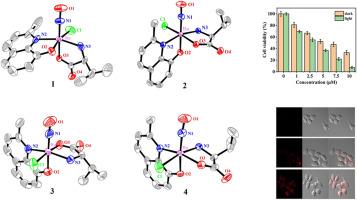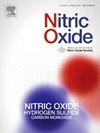Synthesis, structure, spectra, cytotoxicity and photo induced NO release of four isomeric nitrosylruthenium complexes
IF 3.2
2区 生物学
Q2 BIOCHEMISTRY & MOLECULAR BIOLOGY
引用次数: 0
Abstract
Four isomeric nitrosyl ruthenium complexes [RuCl(2mqn)(Val)(NO)] (1–4) were prepared (2mqn, 2-methyl-8-hydroxyquinoline; Val, l-valine) and characterized by 1H NMR, 13C NMR, absorption spectrum, electrospray ionization mass spectrometry, and X-ray crystal diffraction. Time-resolved FT-IR and fluorescence spectroscopy were used to monitor photo-induced NO release in solution, while NO released in living cells was imaged using a selective fluorescent probe. The isomeric complexes showed different levels of cytotoxicity against HeLa cells, and slightly photo-enhanced anti-proliferative activity was observed. The isomeric complexes 1–4 inhibited the growth of HeLa cells by inducing apoptosis and promoted cell cycle arrest in the S phase. Furthermore, they showed relatively lower cytotoxicity against the human liver cell line HL-7702. The different spatial configurations of the complexes is close related with the selective binding of the isomeric complexes with serum albumin, which provide insight into the potential applications of the nitrosyl ruthenium complexes.

四种异构亚硝基钌络合物的合成、结构、光谱、细胞毒性和光诱导 NO 释放。
制备了四种异构亚硝基钌配合物[RuCl(2mqn)(Val)(NO)](1-4)(2mqn,2-甲基-8-羟基喹啉;Val,L-缬氨酸),并通过 1H NMR、13C NMR、吸收光谱、电喷雾离子化质谱和 X 射线晶体衍射进行了表征。利用时间分辨傅立叶变换红外光谱和荧光光谱监测溶液中光诱导的 NO 释放,同时利用选择性荧光探针对活细胞中释放的 NO 进行成像。异构体复合物对 HeLa 细胞表现出不同程度的细胞毒性,并观察到轻微的光增强抗增殖活性。异构复合物 1-4 通过诱导细胞凋亡抑制了 HeLa 细胞的生长,并促进细胞周期停滞在 S 期。此外,它们对人类肝细胞系 HL-7702 的细胞毒性相对较低。复合物的不同空间构型与异构复合物与血清白蛋白的选择性结合密切相关,这为亚硝基钌复合物的潜在应用提供了启示。
本文章由计算机程序翻译,如有差异,请以英文原文为准。
求助全文
约1分钟内获得全文
求助全文
来源期刊

Nitric oxide : biology and chemistry
生物-生化与分子生物学
CiteScore
7.50
自引率
7.70%
发文量
74
审稿时长
52 days
期刊介绍:
Nitric Oxide includes original research, methodology papers and reviews relating to nitric oxide and other gasotransmitters such as hydrogen sulfide and carbon monoxide. Special emphasis is placed on the biological chemistry, physiology, pharmacology, enzymology and pathological significance of these molecules in human health and disease. The journal also accepts manuscripts relating to plant and microbial studies involving these molecules.
 求助内容:
求助内容: 应助结果提醒方式:
应助结果提醒方式:


